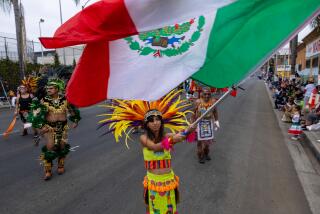Holiday About Service, Not Sales
âCesar Chavez Day White Sale,â the ad read.
Paul Chavez, the son of Cesar E. Chavez, joked this week about the Central Valley newspaper ad, an inevitable byproduct of how we Americans often tend to mark the passage of a holiday.
âYou know you hit the big time when someone has a sale about you,â he laughed.
But department store sales, lazy three-day weekends and a day off from school are what the relatives of the late United Farm Workers Union leader are determined to avoid as they shape Californiaâs newest holiday.
âWe will make sure the legacy of my father is carried out in a meaningful way, substantive and respectful of his works,â Paul Chavez said. âWe were concerned that the holiday be more than just another day off.â
Monday marks the stateâs second annual Cesar Chavez Day of Service and Learning. After a long campaign to declare his March 31 birthday a state holiday, its supporters are setting out to establish new traditions and ways to honor the man who still is provoking political debates, more recently over whether city and state workers really need a day off to celebrate his memory.
Just as the federal holiday for Martin Luther King Jr. has evolved into a day of parades, prayer and multicultural exchanges, Cesar Chavez promoters want their state holiday devoted to community service and educating young people.
âWe are viewing the construction of a new holiday and all the rights and rituals that go with it,â said Jorge Garcia, dean of the School of Humanities at Cal State Northridge and a professor of Chicano studies.
Garcia predicts that holiday commemorations will grow in popularity over the years because of the immensity of the Latino population in California and other states.
But, whatâs emerging in lessons, lectures, Web sites and publicity materials particularly geared to youth is the presentation of Chavez not so much as a champion of farm workers or even as a Latino icon, but as a contemporary American hero.
Andres Irlando, executive director of the nonprofit Cesar E. Chavez Foundation in Los Angeles, said that to keep his legacy relevant today, Chavez is being presented as a âuniversal, ecumenical figure who stood for values that transcend one particular movement.... He is harmonious with very basic American ideals of justice, equality and freedom.â
To help establish the fledgling holiday, the state gave nearly $5 million in 2001 and again this year to fund 64 community service projects and education campaigns. There are the basic school beautification murals to be painted, poetry to be read and essays to be written.
There are ambitious projects, like an Orange County plan to allow 2,800 second-graders from 20 schools to glean leftover vegetables from harvested fields and donate the produce to food banks.
In Sacramento County, elementary school children will rescue duck eggs from a rice field that is about to be plowed under. The state gave the so-called Project Net a $23,000 grant for incubators and the hatched ducklings will be released into the wild.
The Chavez foundation and the Mexican Cultural Institute will host a community festival at La Placita Olvera in downtown Los Angeles on Sunday afternoon, with presentations, a photo exhibit and activities for children.
On Thursday evening, the Monterey Park Boys and Girls Club was packed with 300 youths and their parents for a celebration that could have been a textbook example of what the Chavez family and foundation is aiming for.
With a $108,000 state grant, the club designed a âWorld Peacemakers Hall of Fame,â with a poster-size portrait of a smiling Chavez hanging between Mother Teresa and Martin Luther King Jr.
The youths have read biographies about the poor son of migrant farm workers who had only an eighth-grade education but galvanized grape and lettuce pickers and gained national support for what became the United Farm Workers Union.
A photo wall gave a pictorial history of Chavez, including pictures of his family during the Depression, Chavez limping with blistered feet during a 1966 march to Sacramento for better working conditions for farm laborers, Chavez fasting in 1988 to protest the use of pesticides. He is shown signing a landmark union contract in 1970 with growers.
Chavez Admired for His Nonviolent Ways
âI kind of heard of him before, but didnât really know what he was about,â said Andrea Hernandez, 16, of Rosemead. âWhat I like about him are his nonviolent ways. We have all these drive-bys and violence, but he never used violence to achieve his goals.â
Priscilla Cordova, 13, of Monterey Park said she knew that Cesar Chavez led strikes, but didnât know why. âBut now I learned how you can touch peopleâs lives by doing good works.â
Cordova and Hernandez will be part of a group of youths who will help rebuild a playground for farm workersâ children near Chavezâs burial site at La Paz, the farm workers national headquarters in Keene, Calif., near Tehachapi.
Already, four other states--Texas, New Mexico, Arizona and Colorado--have declared Cesar Chavez holidays. Across the country at least 29 schools, 17 streets, 17 libraries and parks, four plazas and one bridge have been named after him since his death in 1993 at age 66.
Several cities, including San Fernando, give their employees the day off. (Because the birthday falls on a Sunday this year, those city and state workers will have Monday off.)
That has come, of course, with some debate.
Only last week a shouting match broke out in Los Angeles City Hall when the council debated whether to allow city employees to take Cesar Chavez Day as a paid day off instead of Columbus Day. While some workers took a day, union negotiations will decide the final outcome.
Chavez supporters worry that as the holiday grows, so does the potential for trivialization and commercial corruption.
Backers Worry About Beer, Tobacco Sponsors
âLook at whatâs happened to Cinco de Mayo with beer and tobacco sponsors having their name on everything,â professor Garcia said, recalling a restaurant table card he saw last year promoting âEl drinko for el Cinco.â
While some commercial buy-in is important to support the holiday, the challenge will be to keep it focused on the man and his values, according to Garcia.
A team of scholars, teachers and relatives worked through the summer to assemble a Web-based school curriculum on Chavez, which was unanimously approved by the State Board of Education last month. On the site, users have access to grade-appropriate lessons, biographies, videos and primary resources on Chavez.
Gov. Gray Davis called on the stateâs about 210,000 workers to seek volunteer opportunities in their hometowns on Monday.
Leone Tiffany, an office worker at the Ronald Reagan state building, said she will refrain from eating grapes or lettuce on Monday, in remembrance of the Chavezâs 1968 boycott of California grapes. Several other state workers said they will simply relax and enjoy another day off.
Guillermo Hernandez, director of the Chicano Studies Research Center at UCLA, hopes the Chavez holiday will someday reach national dimensions.
âIf someone in 1963 had said a Mexican in 40 years would have libraries and research centers named after him ... people would have said, âYou are out of your mind!ââ Hernandez said. âBut Cesar Chavez is one of the solid foundations of contemporary Chicano leadership in the country.â
*
These Internet sites offer more information about the Cesar E. Chavez Foundation and the new holiday: www.chavezfoundation .org, www.chavezday.ca.gov and www.cde.ca.gov/cesarchavez.
*
Times staff writer Milton Carrero Galarza contributed to this report.
More to Read
Sign up for Essential California
The most important California stories and recommendations in your inbox every morning.
You may occasionally receive promotional content from the Los Angeles Times.










